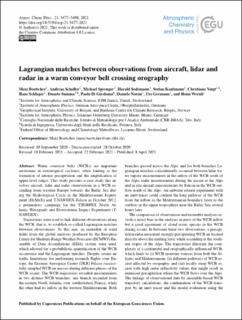| dc.description.abstract | Warm conveyor belts (WCBs) are important airstreams in extratropical cyclones, often leading to the formation of intense precipitation and the amplification of upper-level ridges. This study presents a case study that involves aircraft, lidar and radar observations in a WCB ascending from western Europe towards the Baltic Sea during the Hydrological Cycle in the Mediterranean Experiment (HyMeX) and T-NAWDEX-Falcon in October 2012, a preparatory campaign for the THORPEX North Atlantic Waveguide and Downstream Impact Experiment (T-NAWDEX).
Trajectories were used to link different observations along the WCB, that is, to establish so-called Lagrangian matches between observations. To this aim, an ensemble of wind fields from the global analyses produced by the European Centre for Medium-Range Weather Forecasts (ECMWF) Ensemble of Data Assimilations (EDA) system were used, which allowed for a probabilistic quantification of the WCB occurrence and the Lagrangian matches. Despite severe air traffic limitations for performing research flights over Europe, the German Aerospace Center (DLR) Falcon successfully sampled WCB air masses during different phases of the WCB ascent. The WCB trajectories revealed measurements in two distinct WCB branches: one branch ascended from the eastern North Atlantic over southwestern France, while the other had its inflow in the western Mediterranean. Both branches passed across the Alps, and for both branches Lagrangian matches coincidentally occurred between lidar water vapour measurements in the inflow of the WCB south of the Alps, radar measurements during the ascent at the Alps and in situ aircraft measurements by Falcon in the WCB outflow north of the Alps. An airborne release experiment with an inert tracer could confirm the long pathway of the WCB from the inflow in the Mediterranean boundary layer to the outflow in the upper troposphere near the Baltic Sea several hours later.
The comparison of observations and ensemble analyses reveals a moist bias in the analyses in parts of the WCB inflow but a good agreement of cloud water species in the WCB during ascent. In between these two observations, a precipitation radar measured strongly precipitating WCB air located directly above the melting layer while ascending at the southern slopes of the Alps. The trajectories illustrate the complexity of a continental and orographically influenced WCB, which leads to (i) WCB moisture sources from both the Atlantic and Mediterranean, (ii) different pathways of WCB ascent affected by orography, and (iii) locally steep WCB ascent with high radar reflectivity values that might result in enhanced precipitation where the WCB flows over the Alps. The linkage of observational data by ensemble-based WCB trajectory calculations, the confirmation of the WCB transport by an inert tracer and the model evaluation using the multi-platform observations are the central elements of this study and reveal important aspects of orographically modified WCBs. | en_US |

